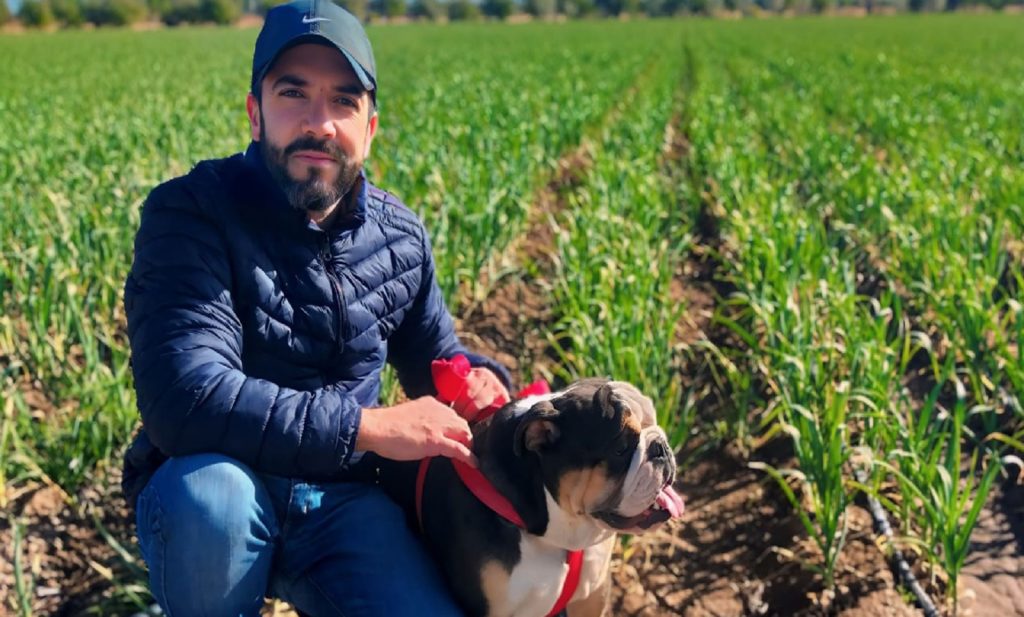
Mendoza always boasts of its wines, its olive oil, its increasingly better gastronomy, now with Michelin stars , with which it impresses the world both abroad and at home. But there is one export product that, although it has stood out for years, never shines in the shop window with the same pride.
We are talking about garlic , a must in any kitchen and in the Mendoza and national diet. Garlic, once again, was the star of Mendoza’s exports in 2024. As reported by ProMendoza , in the first half of the year it was the second most exported product after wine, with revenues of 85 million dollars and a 31% increase in the volume exported compared to the previous half of the year.
With Maximiliano Di Cesare , producer and manager of the Association of Producers, Packers and Exporters of Garlic, Onion and Related Products of Mendoza (ASOCAMEN) we talked about the jump in garlic exports in 2024.
The leader stressed the importance of the activity for Mendoza, its great social impact when it comes to generating capital and intensive labor, its worldwide prestige and the need to eliminate bureaucratic provisions that are “useless” in his view, such as the law that requires signing contracts with producers.
Why did garlic exports increase so sharply in the first half of this year?
Mendoza has always been important in garlic production. In fact, I think it is an activity that deserves to be higher in the public consideration of the people of Mendoza than it is.
The province has a lot of press in terms of wine, which is logical, and I would say on the contrary that garlic has sometimes had a bad press, but it is an extremely important activity for Mendoza, with a lot of projection and very recognized internationally.
How can we measure that level of importance?
Mendoza produces 90% of the garlic produced in Argentina, and 80% of this volume is exported, so we are talking about a purely export sector. In addition, the characteristics of the activity make it very important socially because it is capital and labor intensive.
How many jobs does it generate?
More than 20 thousand jobs, to which we must add all the indirect jobs. Those of us who are in the activity know that when garlic does well, it has an impact on the provincial economy.
In that sense, garlic has never ceased to be important in Mendoza, but I think it has not had the same exposure as wine for a logical reason, perhaps wine is more glamorous.
How do Mendoza garlic producers manage to export almost all of their production when it costs so much to export other products?
There are other important garlic producing countries in the world, which for cultural reasons have a very strong internal consumption and therefore, in the external market they do not appear as strong as Mendoza, which allocates very little garlic to the Argentine market, due to consumer habits.
What is Mendoza’s position worldwide?
Well, Mendoza (Argentina) is normally competing for third place in garlic exports worldwide after China and Spain.
And returning to the first question: Why did garlic exports increase by 31% in volume and 68% in dollars in the first half of the year?
Something happened that is quite objective and we can find part of the explanation there. It is a fact that last season, very strong countries such as Spain and China had climatic difficulties that seriously affected their production.
Enough to have a global impact?
Yes, Spain had problems due to excessive rainfall and lost around 70% of its garlic production last season, and something similar happened to China and it lost 40% of its production.
It must have been a lot
And if we add China and Spain, we are talking about perhaps 300 thousand hectares of garlic that were lost in the previous season.

And how much is that compared to Mendoza’s total garlic production?
About 20 times more, because in Mendoza we have a production of 15,000 hectares.
Of course, there is a huge difference!
Of course, and despite the economic difficulties that mark our activity and other productive activities in the country, we did not have any major climatic shocks, we had a normal harvest and this lack of garlic in the world was felt by the fact that buyers from abroad appeared who approached the province.
What is the season for planting garlic in Mendoza?
Planting is done in February or March, and early varieties are harvested at the end of October or November, and red garlic, which is one of the later varieties, is harvested in December.
It is a long period, almost all year round.
Yes, in our case the cycle is a little longer than that grown in Brazil, but there it is shorter because they plant a garlic called induced garlic, which is a garlic grown in chambers that is subjected to a period of low temperatures that shortens the cycle. On the other hand, our garlic has a more natural cycle than in Brazil.
In what area of the province is it planted?
In general, from Lavalle to Malargüe inclusive, but 60% of production is concentrated in the Uco Valley. In the case of Malargüe, red garlic is produced, which has a longer cycle and there the harvest ends up extending until the first week of January because it is a colder area.
And in the rest of the country, with provinces with similar characteristics, isn’t the same thing happening?
Not to the extent that it occurs in Mendoza. San Juan produces garlic, but it is less compared to ours. The truth is that in the rest of the country garlic could be planted, but well, it is not done.
What are the main markets for Mendoza garlic?
Brazil is the country with 75% to 80% of production, followed by the United States, Taiwan, Spain, France, Italy, the United Kingdom and also Australia.
Then, there are other markets that are also very attractive for us but that are supplied by China, as is the case of Southeast Asia and where China plays it is very difficult to play.
But Brazil takes almost all of our garlic. Why?
Yes, yes, to understand why this is so we have to look at consumption. In Argentina, half a kilo of garlic is consumed per capita per year, and in Brazil, 2 kilos are consumed per capita per year. And there are countries in Southeast Asia such as Malaysia, Thailand, and Indonesia that each consume more garlic per year than Brazil.
That is to say, compared to other countries in the world, we consume garlic, but not as much as in other places in the world, so there is no risk of Argentina importing garlic from other places because there is no market to sell it in our country.
That is why it is very important for us to start working seriously on useless issues that have no beneficiaries and that end up impacting production costs, logistics and marketing dynamics.
For example?
For example, Law 9133 requires the industrial sector to enter into contracts with producers for the acquisition of raw materials.
Of course! The repeal of that law is being debated.
It is a provincial law that was probably enacted with good intentions, perhaps it serves a particular agricultural activity, but I can say that having been applied in a generalized manner, it ended up negatively affecting our activity and other agricultural activities.
Because?
Because this law did not benefit anyone, if they were looking to benefit the producer they have not succeeded. They are unaware of the particularities of the activity and the number of variables that come into play when defining the price for the product.
The law ended up being not only a bureaucratic burden, but it also translates into production costs that end up taking away our competitiveness in the external market, where other countries compete against us without these bureaucratic burdens.
Let’s be clear, when we talk about deregulation we are not talking about a lack of controls, what we are saying is that we should be efficient and more competitive abroad because that will have a very positive impact on the local economy for us.

How?
Because the idiosyncrasy of the Mendoza producer and of the Argentine producer in general, which I know first hand, always brings money back to Mendoza. In our case, if we sell garlic and it goes well, that profit goes back to the farm.
Either the tractor is fixed, or agricultural implements are purchased, the irrigation system is modernized, a new shed is built because the producer is like that, he has a handle and puts it there.
And in the case of the garlic sector, what happens is that it is extremely atomized in terms of its actors and has a strong social impact on the activity.
How many producers are there?
There are more than 2,000 producers throughout the province, some 120 packing sheds and a huge range starting from families who have their small garlic farms of 3, 4 or 5 hectares, so the activity has a very important impact at a social level.
And when you look at exports, there will be one producer that is bigger than another, but in the best case scenario it will have 10% of the total production, that is, there are not two or three players that manage the business.
With the export potential it is possible to expand the area cultivated with garlic despite the water shortage?
Yes, it is possible. There are many farms today that are uncultivated and could be producing, other farms that are producing much less than their potential due to current issues and, in addition, yields can be increased without increasing the surface area, but by applying technology that can achieve a substantial increase in garlic production.
What is that technology?
The one used by Brazil is to use virus-free seeds, seeds that have been previously freed from the natural viral complexes they contain. This procedure allows for greater bulb development and thus higher yields are achieved.
You mentioned China as one of the powers that cannot be competed against, and there is a dispute with China, in which even the government is demanding that Brazil prevent the entry of Chinese garlic into that country.
This has been going on for many years now. The countries that make up Mercosur have tariffs on products from countries outside the bloc. In the case of garlic, there is a 35% tariff, but Brazil, as a large consumer of garlic, also has a protection for its local production called an anti-dumping tariff, which is applied to the import of Chinese garlic.
It doesn’t let him in directly
It is a measure of local protection because Chinese garlic is actually very cheap, Brazil has even higher production costs than ours, which are already high, and needs this protection to protect its local producers.
Of course, Chinese garlic comes in and local production disappears.
There is definitely no way to compete with China there.
How have exports performed in previous years?
We have maintained stable values since previous seasons. Due to technological improvements that lead to quantitative growth, we can speak of higher figures than in other times, because, in addition, Mendoza has a lot of knowledge regarding garlic production, the production is of excellent quality, with very good yields and it is a garlic that is highly sought after in the world and highly appreciated for the climatic, soil and water conditions.


